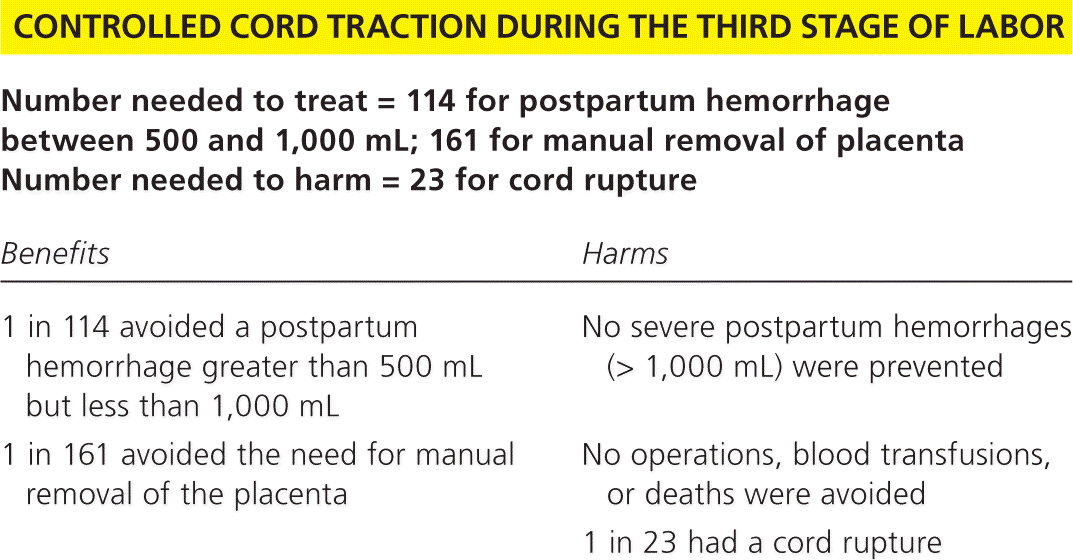
This is a corrected version of the article that appeared in print.
Am Fam Physician. 2016;93(5):online
Author disclosure: No relevant financial affiliations.


| Number needed to treat = 114 for postpartum hemorrhage between 500 and 1,000 mL; 161 for manual removal of placenta Number needed to harm = 23 for cord rupture | |
|---|---|
| Benefits | Harms |
| 1 in 114 avoided a postpartum hemorrhage greater than 500 mL but less than 1,000 mL | No severe postpartum hemorrhages (> 1,000 mL) were prevented |
| 1 in 161 avoided the need for manual removal of the placenta | No operations, blood transfusions, or deaths were avoided |
| 1 in 23 had a cord rupture | |
Details for This Review
Study Population: Healthy women, 18 years or older, with a single intrauterine pregnancy with imminent vaginal delivery and no contraindication to oxytocin (Pitocin)
Efficacy End Points: Incidence of postpartum hemorrhage; manual removal of the placenta
Harm End Points: Maternal morbidity and mortality; nonprespecified outcomes of uterine inversion and cord rupture
Narrative: The third stage of labor, defined as the time frame between delivery and the complete removal of the placenta, is often actively managed by the delivering physician. One component, controlled cord traction, has been thought to reduce the likelihood of postpartum hemorrhage. This review examined three randomized trials (N = 27,873) of controlled cord traction vs. no controlled cord traction and compared blood loss, duration of third stage of labor, morbidity, and mortality.
The studies demonstrated a reduction in cases of blood loss greater than 500 mL but less than 1,000 mL (number needed to treat [NNT] = 114; relative risk [RR] = 0.93; 95% confidence interval [CI], 0.88 to 0.99) and manual removal of the placenta (NNT = 161; RR = 0.69; 95% CI, 0.57 to 0.83). No difference was identified in the risk of postpartum hemorrhage greater than 1,000 mL. There were no differences in blood transfusions, maternal deaths, severe morbidity, operative procedures, use of additional uterotonics, or maternal satisfaction.
Caveats: Overall, the evidence quality was high because all three studies were methodologically sound and included large sample sizes. The inability to blind the study participants is a possible source of bias, although this risk was minimized by objective measurement of blood loss (achieved by weighing vaginal drapes or using a graduated collector bag). The largest study, analyzing the incidence of manual placenta extraction, occurred in locations where the drug ergometrine was used routinely in the third stage of labor, which may have influenced results.
The studies were not specifically designed to study harm end points such as uterine inversion and cord rupture (nonprespecified outcomes). There was just one reported case of uterine inversion occurring with the use of controlled cord traction. Only one of three studies reported data on cord rupture, finding it more common with controlled cord traction (89 of 2,034 vs. 2 of 2,024, number needed to harm [NNH] = 23).
Given the lack of reduction in risk of severe postpartum hemorrhage, the authors conclude that controlled cord traction may not be necessary. They maintain that patients who desire a minimally invasive delivery may reasonably be supported in their preference by omitting controlled cord traction. However, birth attendants must balance the small increased risk of manual placenta removal when controlled cord traction is not performed against the increased risk of cord rupture when it is performed. Current guidelines within Advanced Life Support in Obstetrics (ALSO) support the use of controlled cord traction in the third stage of labor (https://www.aafp.org/cme/programs/also/courses.html). [corrected]
Conclusion: The overall risk-to-benefit ratio of controlled cord traction is unclear. Controlled cord traction reduces the risk of postpartum hemorrhage greater than 500 mL but less than 1,000 mL and slightly reduces the incidence of manual placenta removal, which are both important outcomes to physicians and patients. However, trained physicians performing controlled cord traction should understand that postpartum hemorrhage greater than 1,000 mL is not reduced and appreciate the risk of an increased incidence of cord rupture.1
This series is coordinated by Dean A. Seehusen, MD, MPH, AFP Contributing Editor, and Daniel Runde, MD, from the NNT Group (theNNT.com).
A collection of Medicine by the Numbers published in AFP is available at https://www.aafp.org/afp/mbtn.
The opinions and assertions contained herein are the private views of the authors and are not to be construed as official or as reflecting the views of the U.S. Air Force Medical Department or the U.S. Air Force at large.
This review is available from the NNT Group at http://www.thennt.com/nnt/controlled-cord-traction-third-stage-labor/.
